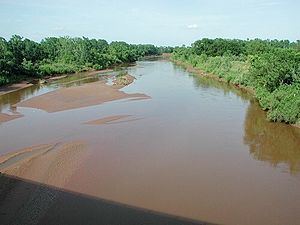Basin size 7,870 sq mi (20,400 km2) Cities Clinton | Length 475 km | |
 | ||
Main source Roberts County, Texas3,028 ft (923 m) River mouth Lake Texoma; 617 ft (188 m); 33°54′42″N 96°34′41″W / 33.9117669°N 96.5780504°W Coordinates: 33°54′42″N 96°34′41″W / 33.9117669°N 96.5780504°W | ||
Washita river monster
The Washita River is a river in the states of Texas and Oklahoma in the United States. The river is 295 miles (475 km) long and terminates at its confluence with the Red River, which is now part of Lake Texoma (33°55′N 96°35′W) on the Texas–Oklahoma border.
Contents
- Washita river monster
- Map of Washita River Oklahoma USA
- The washita river overflows its banks during floods in clinton oklahoma hd stock footage
- Geography
- Tributaries
- History
- References
Map of Washita River, Oklahoma, USA
The washita river overflows its banks during floods in clinton oklahoma hd stock footage
Geography
The Washita River forms in eastern Roberts County, Texas (35°38′N 100°36′W), near the town of Miami in the Texas Panhandle. The river crosses Hemphill County, Texas and enters Oklahoma in Roger Mills County. It cuts through the Oklahoma counties of Roger Mills, Custer, Washita, Caddo, Grady, Garvin, Murray, Carter, and Johnston before emptying into Lake Texoma, which is the modern border between Bryan County and Marshall County.
The river bisects the heart of the Anadarko Basin, the fifth-largest natural gas formation area in the United States. When the river reaches the Arbuckle Mountains, it drops 30 feet per mile (5.7 m/km) as it cuts through Big Canyon, a limestone gorge 300 feet (91 m) deep.
The Washita's river bed is made up of unstable mud and sand, and its banks are composed of steeply incised and erosive red earth. This makes it one of the most silt-laden streams in North America.
Tributaries
Along its path, the Foss Dam impounds the Washita River in Custer County to create the huge Foss Reservoir. Several reservoirs in the Washita River valley hold the waters of small tributaries, including Fort Cobb Lake, Lake Chickasha, and Arbuckle Reservoir.
History
French explorers discovered the Washita River in the early 18th century while traveling upstream on the Red River and thought it was the same stream described by friendly Choctaw tribesmen as the Ouachita River. They soon found that it appeared very different from descriptions of the Ouachita, and named it the Faux Ouachita (False Ouachita). The name was later corrupted by American settlers to False Washita. After the American Civil War, the river was simply known as the Washita.
In 1842, General and future President Zachary Taylor established Fort Washita near the lower end of the river to protect resettled citizens of the Choctaw and Chickasaw Nations from the Plains Indians inhabiting the area. The fort was about 19 miles (31 km) above where the Washita River merged with the Red River.
The Battle of Washita River (or the Washita River Massacre) occurred at dawn on November 27, 1868 when Lt. Col. George Armstrong Custer’s 7th U.S. Cavalry attacked Black Kettle’s Cheyenne village on the Washita River near present-day Cheyenne, Oklahoma.
